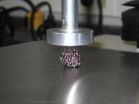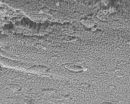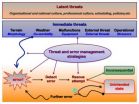(Press-News.org) Forget everything you know about what a loudspeaker should look like. Scientists at Disney Research, Pittsburgh have developed methods using a 3D printer to produce electrostatic loudspeakers that can take the shape of anything, from a rubber ducky to an abstract spiral.
The simple speakers require little assembly, but even those few manual steps might be eliminated in the future, said Yoshio Ishiguro, a Disney Research, Pittsburgh post-doctoral associate. "In five to 10 years, a 3D printer capable of using conductive materials could create the entire piece," he predicted.
The method developed by Ishiguro and Ivan Poupyrev, a former Disney Research, Pittsburgh principal research scientist, will be presented April 29 at the Conference on Human Factors in Computing Systems (CHI) in Toronto.
The speaker technology could be used to add sound to any number of toys or other objects. Because the same speakers that produce audible sound also can produce inaudible ultrasound, the objects can be identified and tracked so that they can be integrated into games and other interactive systems. The objects can be touched or held in a user's hand without a noticeable decrease in sound quality, so simple tactile feedback may also be possible.
The speakers are based on electrostatic speaker technology that was first explored in the early 1930s, but never widely adopted. This type of speaker is simpler than conventional electromagnetic speakers and includes no moving parts, which makes it suitable for producing with a 3D printer.
An electrostatic speaker consists of a thin, conductive diaphragm and an electrode plate, separated by a layer of air. An audio signal is amplified to high voltage and applied to the electrode; as the electrode charges, an electrostatic force develops between it and the diaphragm, causing the diaphragm to deform and produce sound as the audio signal changes.
This type of speaker has relatively little bass response, but does a good job of producing high-frequency sounds, such as chirping birds, computer-generated blips and even the human voice. Sound reproduction of up to 60 decibels is possible – an appropriate level for small objects.
"What's more, it can generate sound across the entire face of the speaker," Ishiguro noted. That makes it possible to not only produce directional, cone-shaped speakers but also omnidirectional speakers in which the entire 3D surface emits sound.
Also, the speakers can be built with any number or configuration of electrodes; placing multiple electrodes in a curved speaker, for instance, makes it possible to vary the direction of the sound emitted.
Ishiguro and Poupyrev created conductive surfaces by spraying a nickel-based conductive paint and developed a method for making full-body compliant diaphragms using negative molds produced by 3D printing and spraying them with the conductive paint and with a polyethylene coating. Once multi-material 3D printers are developed that can print functional electrical circuits and electrodes, these manual steps could be eliminated.
INFORMATION:
More information about 3D-printed interactive speakers, including a video, is available on the project web site at http://www.disneyresearch.com/project/printed-speakers/
About Disney Research
Disney Research is a network of research laboratories supporting The Walt Disney Company. It's purpose is to pursue scientific and technological innovation to advance the company's broad media and entertainment efforts. Disney Research is managed by an internal Disney Research Council co-chaired by Disney-Pixar's Ed Catmull and Walt Disney Imagineering's Bruce Vaughn, and including the Directors of the individual labs. It has facilities in Los Angeles, San Francisco, Pittsburgh, Boston and Zürich. Research topics include computer graphics, video processing, computer vision, robotics, radio and antennas, wireless communications, human-computer interaction, displays, data mining, machine learning and behavioral sciences.
Disney Researchers use 3D printing to produce interactive speakers of any shape
If it looks like a duck and sounds like a duck, it just might be a loudspeaker
2014-04-28
ELSE PRESS RELEASES FROM THIS DATE:
Increasing the diversity of marketable raspberries
2014-04-28
COLLEGE PARK, MD -- Raspberries are the third most popular berry in the United States. Their popularity is growing as a specialty crop for the wholesale industry and in smaller, local markets, and U-pick operations. As consumer interest in the health benefits of colorful foods increases, small growers are capitalizing on novelty fruit and vegetable crops such as different-colored raspberries. Authors of a newly published study say that increasing the diversity of raspberry colors in the market will benefit both consumers and producers. "Producers will need to know how fruit ...
A system detects global trends in social networks 2 months in advance
2014-04-28
This news release is available in Spanish. A new method of monitoring identifies what information will be relevant on social networks up to two months in advance. This may help predict social movements, consumer reactions or possible outbreaks of epidemics, according to a study in the Universidad Carlos III of Madrid (UC3M) is participating.
The aim of the research, on which scientists from the Universidad Autónoma of Madrid, the NICTA of Australia, and the American universities Yale and the University of California-San Diego have also collaborated, was to test what ...
Researchers identify potential new strategy to treat ovarian cancer
2014-04-28
Scientists studying cancerous tumour tissues in a laboratory believe they have identified a potential new strategy to treat ovarian cancer – which affects around 7,000 women in the UK each year.
Recently developed drugs have increased patient survival rates by targeting a tumour's blood vessels that supply essential nutrients and oxygen to cancer cells.
However, many patients go on to develop resistance to these therapies and grow new blood vessels that spread the cancer again.
A team from The University of Manchester – part of the Manchester Cancer Research Centre ...
Genetic disorder causing strokes and vascular inflammation in children has been discovered
2014-04-28
Academy research fellows from University of Turku (Finland), Andrey and Anton Zavialov, and a team of researches from the National Institutes of Health (NIH), USA, discovered that inherited mutations in a blood enzyme called ADA2 cause a syndrome of sporadic fevers, skin rashes and recurring strokes, beginning early in childhood. The novel genetic disorder was called deficiency of ADA2, or DADA2.
The disease has a broad range of symptoms and its severity varies significantly, which represent a problem for making an accurate diagnosis. Since the cause of the disease is ...
Australian marine reserves provide safe passageway for endangered species
2014-04-28
The value of Australia's newly established network of marine parks has been highlighted by an international project that used satellites to track the vulnerable flatback sea turtle. The findings are published in Springer's journal Marine Biology. In the study, researchers from Deakin University (Australia), Swansea University (U.K.) and Pendoley Environmental consultancy (Australia) used advanced satellite tracking systems to record the passage of more than 70 flatbacks off the north-west Australian coastline.
A high value migratory corridor, more than 1,000 kilometres ...
Flexible battery, no lithium required
2014-04-28
HOUSTON – (April 28, 2014) – A Rice University laboratory has flexible, portable and wearable electronics in its sights with the creation of a thin film for energy storage.
Rice chemist James Tour and his colleagues have developed a flexible material with nanoporous nickel-fluoride electrodes layered around a solid electrolyte to deliver battery-like supercapacitor performance that combines the best qualities of a high-energy battery and a high-powered supercapacitor without the lithium found in commercial batteries today.
The new work by the Rice lab of chemist James ...
Applying lessons from NASA helps manage threats and errors in pediatric cardiac surgery
2014-04-28
Toronto, ON, Canada, April 28, 2014 – All high-stakes industries that function at very high "6-sigma" safety levels have a pre-occupation with human error. The aviation industry epitomizes this concept; during the 1970s NASA and aviation researchers realized that humans are the least reliable resource in the cockpit. Subsequent research into >30,000 flights has confirmed that human error is inevitable, ubiquitous, and therefore needs to be understood and managed. Mismanaged error leads to cycles of further error and unintended states, with consequent loss of safety margins. ...
Complications from kidney stone treatments are common and costly
2014-04-28
DURHAM, N.C. – Despite their overall low risk, procedures to treat kidney stones lead to complications that require hospitalization or emergency care for one in seven patients, according to researchers at Duke Medicine.
These complications are costly. Patients who have an unplanned visit face an average cost of nearly $30,000, depending on the type of procedure and the subsequent care.
"Our findings provide a good starting point to understand why these complications are happening and how they can be prevented, because the costs to patients who suffer complications ...
Research shows strategic thinking strengthens intellectual capacity
2014-04-28
Strategy-based cognitive training has the potential to enhance cognitive performance and spill over to real-life benefit according to a data-driven perspective article by the Center for BrainHealth at The University of Texas at Dallas published in the open-access journal Frontiers in Systems Neuroscience. The research-based perspective highlights cognitive, neural and real-life changes measured in randomized clinical trials that compared a gist-reasoning strategy-training program to memory training in populations ranging from teenagers to healthy older adults, individuals ...
Weekly emails to hospital C-suite halt 2 decades of superbug outbreak
2014-04-28
Washington, DC, April 28, 2014 – Efforts to reduce and stop the spread of infections caused by a highly resistant organism, carbapenem-resistant Acinetobacter baumannii, at a large Florida hospital proved ineffective until they added another weapon – weekly emails from the medical director of Infection Control to hospital leadership, according to a study published in the May issue of the American Journal of Infection Control, the official publication of the Association for Professionals in Infection Control and Epidemiology (APIC).
When the hospital added the step of ...
LAST 30 PRESS RELEASES:
Jeonbuk National University study shows positive parenting can protect adolescents against self-harm
Surface-engineered ZnO nanocrystals to tackle perfluoroalkyl substance contamination
This new understanding of T cell receptors may improve cancer immunotherapies
A new fossil face sheds light on early migrations of ancient human ancestor
A new immunotherapy approach could work for many types of cancer
A new way to diagnose deadly lung infections and save lives
40 percent of MRI signals do not correspond to actual brain activity
How brain-inspired algorithms could drive down AI energy costs
Gum disease may be linked to plaque buildup in arteries, higher risk of major CVD events
Contrails are a major driver of aviation’s climate impact
Structure of dopamine-releasing neurons relates to the type of circuits they form for smell-processing
Reducing social isolation protects the brain in later life
Keeping the heart healthy increases longevity even after cancer
Young adults commonly mix cannabis with nicotine and tobacco
Comprehensive review illuminates tau protein's dual nature in brain health, disease, and emerging psychiatric connections
Book prepares K-12 leaders for the next public health crisis
Storms in the Southern Ocean mitigates global warming
Seals on the move: Research reveals key data for offshore development and international ecology
Sports injuries sustained during your period might be more severe
World's first successful 2 Tbit/s free-space optical communication using small optical terminals mountable on satellites and HAPS
Can intimate relationships affect your heart? New study says ‘yes’
Scalable and healable gradient textiles for multi‑scenario radiative cooling via bicomponent blow spinning
Research shows informed traders never let a good climate crisis go to waste
Intelligent XGBoost framework enhances asphalt pavement skid resistance assessment
Dual-function biomaterials for postoperative osteosarcoma: Tumor suppression and bone regeneration
New framework reveals where transport emissions concentrate in Singapore
NTP-enhanced lattice oxygen activation in Ce-Co catalysts for low-temperature soot combustion
Synergistic interface engineering in Cu-Zn-Ce catalysts for efficient CO2 hydrogenation to methanol
COVID-19 leaves a lasting mark on the human brain
Scientists use ultrasound to soften and treat cancer tumors without damaging healthy tissue
[Press-News.org] Disney Researchers use 3D printing to produce interactive speakers of any shapeIf it looks like a duck and sounds like a duck, it just might be a loudspeaker


